Saturday, April 30, 2016
Beware of Unsafe User-Generated Content [Infographic]
Friday, April 29, 2016
Stop Neglecting Analytics in Your Customer Engagement Strategy
Customers desire experiences, not transactions.
In a world full of distractions, engaging customers beyond the typical purchasing routine is vital for SaaS success.
And B2B consumers crave unparalleled engagement. They want personalized advice, solution-oriented features, and revenue-generating products.
An IBM annual survey noted that “as many as 65% believe customer engagement will be the primary driver of growth going forward.”
Analytics is one of the few ways to gain insights to meet your customers' needs. It helps bridge the gap between providing a service to solving real challenges.
Enhance the experience between your brand and consumers. Build data into your customer engagement strategy.
It Starts With Value
Studies show that “86% of buyers will pay more for a better customer experience, but only 1% of customers feel that vendors consistently meet their expectations.” That's a major disconnect for SaaS companies striving to improve customer engagement.
B2B customers aren't concerned about aesthetic features. And they aren't amped to hear how your team worked around the clock to fix a bug.
Your consumers want a service dedicated to solving their problems in an efficient manner.
Natalie Chan, an expert handling customer retention at Outbrain Amplify, writes:
“Businesses that focus on customers engagement are focused on value creation, not revenue extraction. These are businesses that know how to engage their customers by providing them with real value whether it be through an exceptional end-to-end customer experience, great content or strong customer support that are about delivering more than the traditional sell.”
Offering value means addressing your customers' desires. And it's all about how they perceive what's important.
For example, if a prospect is concerned about increasing open rates in email campaigns, it's not in their best interest to discuss layout designs.
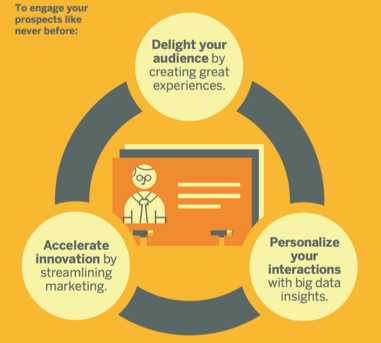
Value requires laser-focus. And that's where analytics steps in.
Monitor usage data to assess the customer experience. Track acquisition channels to observe where customers are coming from and if they're converting.
Interview customers and ask them why they chose your product. Figure out how they expect to use your product and what business goals they want to achieve.
Create and deliver unprecedented value. Connect with the customer.
Know Your Buyer
In order for customer engagement to work effectively, your team must know your buyer. And that goes beyond the usual demographics, like annual revenue, company size, and location.
More importantly, for B2B companies, your team must not only focus on the business itself, but also on the employee of the business. Learning about the decision maker is crucial to your sales.
“Leveraging big data to better understand and act upon customer behavior, forces you to think differently not only about what data to keep (all of it!) and how long to keep it, but also which data you should begin capturing,” states Duane Edwards, Co-founder and Senior Vice President of Globys.
Analyze your primary behavioral data to create in-depth customer personas. Understand the decision maker's goals and challenges. Also, know how you can provide short-term and long-term guidance.
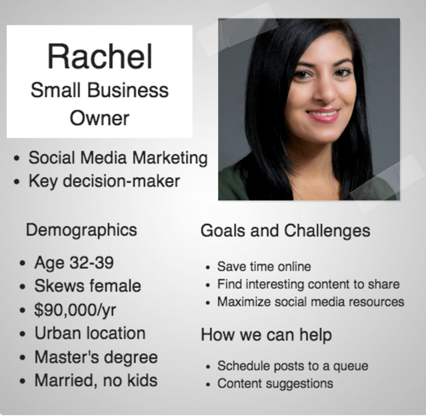
Bruce Swann, Sales and Marketing professional at Adobe, suggests applying predictive analytics:
“Once you've compiled data attributes to create a panoramic view of customers, you can begin to understand and predict customer behavior, which adds depth to that view. Examples include using a range of analyses, including customer value analysis, market basket analysis, customer profitability, response modeling, and churn analysis.”
Use data as an indicator of future behavior. If you know your client's customers, it may lead to helping your client differently.
For example, NoWait is an app that simplifies the process of waiting for a table at a restaurant. Instead of having a guest tote around a clunky pager with a range of 50 feet, restaurants only need the person's cell phone number.
When the table is ready, the guest receives a text. Plus, after dining, restaurants can text customers additional discount offerings.
Moreover, with the app, restaurants learn “who their patrons are, what time they come and go, which patrons come back the most frequently, who purchases more.” This data can be used to create messaging that appeals specifically to each customer.
Know your buyer and your buyer's customers.
Content That Resonates
Content is more than just blog posts. It includes everything from checklists to webinars.
Research shows that “64% of visitors who watch a video are more likely to buy a product online.” Therefore, content isn't just helpful for your brand awareness; it's a vital part of your customer engagement strategy, which leads to sales.
Examine heat map data to improve your content. It will help you learn what content is important to the consumer. Then, your team can focus on content placement and how different images and colors in your content affect your website visitors.
Pete Mehr, Principal at ZS Associates, says, “By quantifying which content the customer engages, and how frequently, it becomes straightforward to continue to provide content back to the customer. This continuing content consists of an ongoing series of messages to a customer.”
Moreover, analytics will uncover which type of content matters to your customer. Is it eBooks? Or maybe 30-second video clips?
Mention understands their audience. They produce content that resonates.
The social monitoring company creates webinars highlighting experts in the field. For instance, Mention invited Sujan Patel (who is hosting a webinar with Kissmetrics next week) to talk about ways to create content for “boring” industries.
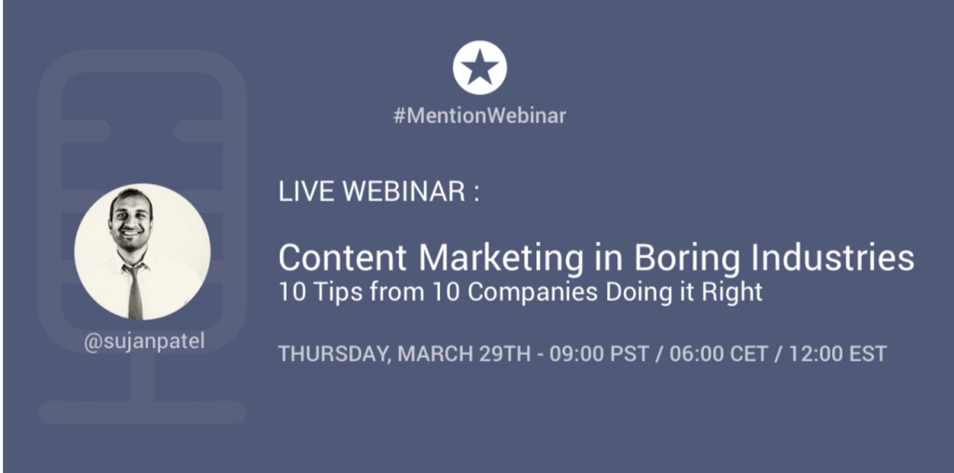
Study your data to find content that speaks to your customer. It's an effective way to boost engagement.
Multi-Channel Customer Service
In America, “the cost of poor customer service is $41 billion per year.” That's a heavy burden for most companies.
Moreover, a report found that “retailers are not listening and responding to their audience enough. Some 89% of consumers' comments are left unanswered.”
Approach customer service differently. Think beyond phone support and Q&A forums.
Social media has presented another solution. Now, SaaS businesses can provide Twitter and Facebook support.
Under Armour created a Twitter handle solely for the purpose of answering customers questions about their products.

From your analytics reports, determine what channels of support satisfies your customers. What works for your competitor may not work for your SaaS.
“It's not about deploying on all channels, but deploying the right channels that align with your business. Only deploy on the channels that make sense for your business,” says Kate Leggett, a principal analyst at Forrester Research.
In addition, you must streamline your processes when using multiple channels. For instance, phone support data for a specific customer must also be available to your Twitter service reps.
At ComputerWeekly.com, Lisa Kelly suggests that “organisations need an accurate knowledge base where companies can link information from other channels, including peer-to-peer interactions, web self-service and communities, to share with customer service agents.”
It's not enough to offer various customer service routes. Your team must work together to use data to enhance the overall customer experience on each channel.
Respect The Data
Customer engagement isn't anything new. However, your SaaS can approach it differently with the help of analytics.
Add unmatched value to the customer's experience. Use data to gain insight on your buyer's habits and preferences. And provide customer service from a multi-channel perspective.
Stop neglecting, and start respecting your data.
About the Author: Shayla Price lives at the intersection of digital marketing, technology and social responsibility. Connect with her on Twitter @shaylaprice.
#SocialSkim: What Facebook's Algorithm Change Means, Plus 12 More Stories in This Week's Roundup
How To Stop Worrying & Love Your Blog
OK, so you have been told that you must write a blog for your company website, but you have the constant nagging questions at the back of your mind - is it worth it, do I have time? Well, the […]
Post from: Search Engine People SEO Blog
How To Stop Worrying & Love Your Blog
--
Written by Danny Hall, FSE Online
The post How To Stop Worrying & Love Your Blog appeared first on Search Engine People Blog.
Business Advice & Wisdom for Young Family Entrepreneurs (FS160)
Running an indie business is more possible than ever - even when you've got a young baby or a new marriage. But if you try to simply burn more candles at more ends (or pour more cups of coffee to get through the day) you'll find yourself and your family paying a price too high.
On the show today, some wisdom and advice for entrepreneurs in young families. Steph's about to have a baby, Barrett's about to get married and Chase and Corbett have lived through enough of these experiences to have a valuable vantage point.
Regardless of how far down the road of family or business you are, if you want to live well, you're going to love this episode. Enjoy!
Business Advice & Wisdom for Young Family Entrepreneurs
href='https://twitter.com/intent/tweet?text=Business Advice & Wisdom for Young Family Entrepreneurs&url=https://fizzle.co/sparkline/business-advice-wisdom-for-young-family-entrepreneurs-fs160&via=fizzle'
title='Click to share on Twitter!'>Tweet This
Show Notes
Female Company President: 'I'm sorry to all the mothers I worked with':
“I was now a woman with two choices: go back to work like before and never see my baby; or pull back on my hours and give up the career I'd built over the last ten years. When I looked at my little girl, I knew I didn't want her to feel trapped like me.”
Alan Watts (@AlanWattsDaily) | Twitter
“The immediate now, whatever its nature, is the goal and fulfillment of all living. Flowing from this insight is an emotional ecstasy, a sense of intense relief and lightness, and of almost unbearable love for the world.” ~ Alan Watts
Having It All Kinda Sucks - Life Tips - Medium
Thursday, April 28, 2016
Search Marketing Solutions For Firms With Franchises
Maintaining a local web presence for a franchise business is a challenge. Each franchise site (or microsite) has to be treated as a separate case and optimized for local search individually. Businesses can ensure its franchise websites show up in […]
Post from: Search Engine People SEO Blog
Search Marketing Solutions For Firms With Franchises
--
Written by Michael Georgiou, Imaginovation
The post Search Marketing Solutions For Firms With Franchises appeared first on Search Engine People Blog.
A Primer for Getting Ahead With Long-Tail Keywords
The Local SEO Agency's Complete Guide to Client Discovery and Onboarding
Posted by MiriamEllis
[Estimated read time: 6 minutes]
Why proper onboarding matters
Imagine getting three months in on a Local SEO contract before realizing that your client's storefront is really his cousin's garage. From which he runs two other “legit” businesses he never mentioned. Or that he neglected to mention the reviews he bought last year. Worse yet, he doesn't even know that buying reviews is a bad thing.
The story is equally bad if you're diligently working to build quality unique content around a Chicago client's business in Wicker Park but then realize their address (and customer base) is actually in neighboring Avondale.
What you don't know will hurt you. And your clients.
A hallmark of the professional Local SEO department or agency is its dedication to getting off on the right foot with a new client by getting their data beautifully documented for the whole team from the start. At various times throughout the life of the contract, your teammates and staff from complementary departments will be needing to access different aspects of a client's core NAP, known challenges, company history, and goals.
Having this information clearly recorded in shareable media is the key to both organization and collaboration, as well as being the best preventative measure against costly data-oriented mistakes. Clear and consistent data play vital roles in Local SEO. Information must not only be gathered, but carefully verified with the client.
This article will offer you a working Client Discovery Questionnaire, an Initial Discovery Phone Call Script, and a useful Location Data Spreadsheet that will be easy for any customer to fill out and for you to then use to get those listings up to date. You're about to take your client discovery process to awesome new heights!
Why agencies don't always get onboarding right
Lack of a clearly delineated, step-by-step onboarding process increases the potential for human error. Your agency's Local SEO manager may be having allergies on Monday and simply forget to ask your new client if they have more than one website, if they've ever purchased reviews, or if they have direct access to their Google My Business listings. Or they could have that information and forget to share it when they jump to a new agency.
The outcomes of disorganized onboarding can range from minor hassles to disastrous mistakes.
Minor hassles would include having to make a number of follow-up phone calls to fill in holes in a spreadsheet that could have been taken care of in a single outreach. It's inconvenient for all teammates when they have to scramble for missing data that should have been available at the outset of the project.
Disastrous mistakes can stem from a failure to fully gauge the details and scope of a client's holdings. Suddenly, a medium-sized project can take on gigantic proportions when the agency learns that the client actually has 10 mini-sites with duplicate content on them, or 10 duplicate GMB listings, or a series of call tracking numbers around the web.
It's extremely disheartening to discover a mountain of work you didn't realize would need to be undertaken, and the agency can end up having to put in extra uncompensated time or return to the client to renegotiate the contract. It also leads to client dissatisfaction.
Setting correct client expectations is completely dependent on being able to properly gauge the scope of a project, so that you can provide an appropriate timeline, quote, and projected benchmarks. In Local, that comes down to documenting core business information, identifying past and present problems, and understanding which client goals are achievable. With the right tools and effective communication, your agency will be making a very successful start to what you want to be a very successful project.
Professional client discovery made simple
There's a lot you want to learn about a new client up front, but asking (and answering) all those questions right away can be grueling. Not to mention information fatigue, which can make your client give shorter and shorter answers when they feel like they've spent enough time already. Meanwhile your brain reaches max capacity and you can't use all that valuable information because you can't remember it.
To prevent such a disaster, we recommend dividing your Local SEO discovery process into a questionnaire to nail down the basics, a follow-up phone call to help you feel out some trickier issues, and a CSV to gather the location data. And we've created templates to get you started...
Client Discovery Questionnaire
Use our Local SEO Client Discovery Questionnaire to understand your client's history, current organization, and what other consultants they might also be working with. We've annotated each question in the Google Doc template to help you understand what you can learn and potential pitfalls to look out for.
If you want to make collecting and preserving your clients' answers extra easy, use Google Forms to turn that questionnaire into a form like this:
You can even personalize the graphic, questions, and workflow to suit your brand.
Client Discovery Phone Script
Once you've received your client's completed questionnaire and have had time to process the responses and do any necessary due diligence (like using our Check Listings tool to check how aggregators currently display their information), it's time to follow up on the phone. Use our annotated Local SEO Client Discovery Phone Script to get you started.
No form necessary this time, because you'll be asking the client verbally. Be sure to pay attention to the client's tone of voice as they answer and refer to the notes under each question to see what you might be in for.
Location Data CSV
Sometimes the hardest part of Local SEO is getting all the location info letter-perfect. Make that easier by having the client input all those details into your copy of the Location Data Spreadsheet.
Then use the File menu to download that document as a CSV.
You'll want to proof this before uploading it to any data aggregators. If you're working with Moz Local, the next step is an easy upload of your CSV. If you're working with other services, you can always customize your data collection spreadsheet to meet their standards.
Keep up to date on any business moves or changes in hours by designing a data update form like this one from SEER and periodically reminding your client contact to use it.
Why mutual signals of commitment really matter
There are two sides to every successful client project: one half belongs to the agency and the other to the company it serves. The attention to detail your agency displays via clean, user-friendly forms and good phone sessions will signal your professionalism and commitment to doing quality work. At the same time, the willingness of the client to take the necessary time to fill out these documents and have these conversations signals their commitment to receiving value from their investment.
It's not unusual for a new client to express some initial surprise when they realize how many questions you're asking them to answer. Past experience may even have led them to expect half-hearted, sloppy work from other SEO agencies. But, what you want to see is a willingness on their part to share everything they can about their company with you so that you can do your best work.
Anecdotally, I've fully refunded the down payments of a few incoming clients who claimed they couldn't take the time to fill out my forms, because I detected in their unwillingness a lack of genuine commitment to success. These companies have, fortunately, been the exception rather than the rule for me, and likely will be for your agency, too.
It's my hope that, with the right forms and a commitment to having important conversations with incoming clients at the outset, the work you undertake will make your Local team top agency and client heroes!
Sign up for The Moz Top 10, a semimonthly mailer updating you on the top ten hottest pieces of SEO news, tips, and rad links uncovered by the Moz team. Think of it as your exclusive digest of stuff you don't have time to hunt down but want to read!
Five Examples of How Publishers Have Used UGC to Grow
How a GREAT Marketer Befriends an Influencer
Have you ever watched a reality competition? You know, one of those Survivor-style shows that puts strangers in a stressful situation to battle for a last-person-standing prize?
Don't be ashamed if you have. I'm a pop culture snob, but still found myself transfixed by ten seasons of America's Next Top Model. On that show, amidst the freak-outs and tantrums, I noticed one recurring line of dialogue:
“I'm not here to make friends.”
You'll hear it on almost every reality competition. There's always one person who alienates everyone else with that specific phrase. Usually it's followed by, “I'm here to win.”
The funny thing is, in all the hours I wisely invested watching would-be models snipe at each other, no one who said that ever won. Not once. In fact, they tended to get kicked off earlier than anyone else.
It's easy for marketers to feel like we're not here to make friends. Even in influencer marketing, it's all about that ROI. Influencer, you get me what I need, we'll compensate you, and that's the end of it. We're here to win.
But just like the models and aspiring pop idols of the world, you'll find that putting effort into building friendships pays off in the end. If you want influencers who are excited about working with you, creating work they're excited to promote, it pays to cultivate a friendship. Not just from a, “it's nicer to work with people when you're nice” angle, either-it's better for the business side, too.
Here are three ways you can cultivate friendships with your influencers.
#1 – Consider People outside of their Interaction with Your Business
This is a piece of advice I've given to marketers thinking about their customers, but it applies to influencers as well. Yes, you're vetting the influencer for the size of their audience and if their audience aligns with your message. But while you're doing that, consider what they do when they're not answering your email.
What are they like? Do they have a good sense of humor? What are their hobbies? Do they talk about their family, their pets, their collection of vintage chainsaws? What kind of music are they into? What movies do they love? It's worth doing a little digging to find out. And I don't mean just social media stalking, either. These questions can start a conversation you might not have had otherwise. We all love talking about ourselves-give them a chance to share interests you might have in common.
#2 – Take – Don't Fake – A Personal Interest
Last December, I got a greeting card in the mail. It had my name and addresses hand-written on the envelope, but no return address. Intrigued, I opened it to read: “Best holiday wishes to you and yours from your friends at [Insurance Company].” I looked at the envelope again, and this time could tell their hand-written address was just a handwriting font. Just like that, any illusion of personal interest they were trying to create was gone.
With your influencers, it's worth taking time to express a genuine personal interest. Let your correspondence show that you have taken time to learn something about them. Send a meme that made you laugh, that you know they would love. Send them a vintage chainsaw to add to their collection. That thoughtfulness goes a long way.
Just make sure you do your homework under point #1, so you're not faking the funk. You wouldn't want to send chocolates to a diabetic, or a vintage chainsaw to someone who collects old Happy Meal toys. That's just a waste of a good chainsaw.
#3 – Strive for Genuine, Enthusiastic Co-Creation
At TopRank, we try to involve influencers in the creation process as actively as possible. We make sure influencers know exactly what project we're working on, why we would love their input, and which other influencers are already on board. We keep the enthusiasm up throughout the process with progress reports. We show them the finished project before we publish it so they can make final edits. And we always make sure to message them right before the project posts, to make it easy for them to promote it.
Compare that approach to simply saying, “Hey, can we get a quote about Happy Meal toys for a blog,” followed by…well, no follow-up at all. There's no comparison.
How a GREAT Marketer Befriends an Influencer
Let's face it: We are here to make friends. In marketing, as in life, friends make good things even better. So to help you cultivate lasting friendships with the influencers in your life, we created this cute-but-serious storybook with some key points to keep in mind. Read it to your kids before bed tonight…or to your significant other while you're binge-watching America's Next Top Model.
Gain a competitive advantage by subscribing to the
TopRank® Online Marketing Newsletter.
© Online Marketing Blog - TopRank®, 2016. |
How a GREAT Marketer Befriends an Influencer | http://www.toprankblog.com
The post How a GREAT Marketer Befriends an Influencer appeared first on Online Marketing Blog - TopRank®.
Wednesday, April 27, 2016
7 Ways to Step Up Your Email Marketing Game in 2016
Email marketing is a great, cost-effective way to engage prospective customers and nurture relationships with current customers. And email is actually welcomed by consumers. In fact, recent research has found that a whopping 91% of Americans say they want to receive promo emails.
But let's face it. With email being one of the most common forms of communication these days, your customers inboxes are most likely a little full. And it's time for you to step up your game if you want to continue connecting with subscribers and encouraging them to do business with you.
While we're almost halfway through 2016, there's still time to make the most of the latest email marketing tricks and trends. Below are seven considerations for creating an emails that will resonate with your audience and help you up your game.
#1 – Remember: It's All About Mobile
This one may seem like a bit of a no-brainer, but nonetheless it needs to be mentioned. Mobile has become an increasingly important consideration for website designers and digital marketers. People rely on their mobile devices for a lot of things–and email is certainly one of them. In fact, studies show that 55% of email is now opened on a mobile device.
Typically, the content should be focused and not too text heavy. But the most important thing to remember is that people want fast loading times. So, if you're using large video or image files, make sure they'll open quickly and easily.
#2 – Personalize Your Message
A one-size-fits-all approach to email marketing is simply not reasonable these days. Your email recipients are interested in messages that are focused on their personal tastes and preferences–addressing them by their first name in the opening is not good enough. Use data insights to create different messaging for individual target groups.
For example, Pinterest does an excellent job at personalization. Every week, I can count on receiving an email with suggested pins or boards to follow that are based on my interests and behaviors on the platform.
Can you tell I'm attempting a diet?
#3 – Understand the “Why”
Spend some time actually thinking about why your subscribers actually open an email. An enticing discount or a new product launch may not be the only reason they click. Think about who your customer is, what they're usually looking for, what's important to them and what season it is. In addition, think about what device they are looking on. Is it a tablet? Smartphone? Basically, dig into the psychology of your customers. This will directly correlate with your ability to personalize your messaging.
#4 – Explore Automation
Automated email campaigns allow you to use a triggering event such as an asset download, contact form fill out or a webinar signup to kick-off a tailored series of emails. Your monthly newsletters or specialty campaigns are definitely important components of your overall email marketing strategy. But email automation can be a very powerful tool that can help you nurture relationships and drive customers to a desired outcome.
For example, if you're hosting an in-person event or webinar, email automation can be used as a way to communicate with attendees before, during and after the event. Content delivered before or during the event would include information on accommodations or the event schedule. Content delivered after the event ends would include special access to event assets and presentations, or perhaps direct them or information on another upcoming event they're interested in.
Determine your triggering events and then create an automation workflow that details what you'll send to them throughout the automation campaign. Here's an example:
#5 – Add Dynamic & Interactive Content
Dynamic and interactive content is something that is pretty new to the email marketing world. Dynamic options could include changing the content of an email based on location or weather, and interactive content could be features like animations or carousel elements. Software tools that can help you do this type of content are HubSpot and MovableInk.
#6 – Use a Lightbox to Grow Your Email List
Lightboxes–or pop-ups–can be an effective way to quickly grow your email list. While some may think they're a bit annoying, lightbox pop-ups bring a connection option to your audience–rather than relying on them to search it out.
If you go this route, make something that's unique rather than using a generic template. Also, use active language that will compel people to do what you're asking. Here's an example from HouseLogic, a home improvement tips and tricks website operated by the National Association of Realtors. They know why their audience is there and uses visuals to entice a sign up.
#7 – Implement Tracking
Having the proper tracking in place so you can gather data and pull insights from your email campaign is crucial. (And really tracking should be an important part of your entire digital marketing campaign.) If you're using Google Analytics, add campaign parameters to the source URL to get a better idea of how many people are coming to your website from email. Check out Google's Email Tracking – Measurement Protocol for step-by-step instructions.
What are some of your email marketing best practices? Tell us in the comments section below.
Header image via Shutterstock
Gain a competitive advantage by subscribing to the
TopRank® Online Marketing Newsletter.
© Online Marketing Blog - TopRank®, 2016. |
7 Ways to Step Up Your Email Marketing Game in 2016 | http://www.toprankblog.com
The post 7 Ways to Step Up Your Email Marketing Game in 2016 appeared first on Online Marketing Blog - TopRank®.
10 Must-Know Facebook Ads Tips & Features
It's no secret that paid social is drastically on the rise. Social advertising spend jumped 50% year-over-year in the last quarter of 2015. Social media ad revenue is expected to reach $35.90 billion by 2017, reaching a staggering 16% of the total global digital ad market.
Facebook (including Instagram) unsurprisingly comprises a big piece of this pie, making up an estimated 65.5% of all 2015 social ad spend. This is driven by changes in their CPC model, launch of Instagram ads & the addition of powerful new features.
This post will arm you with 10 important tips & features to ensure you're getting the most out of this channel.
1. Facebook Lead Ads
One of the most recent campaign types added by Facebook are Lead Ads. This campaign type allows advertisers to collect lead data without a landing page and directly through a form without leaving Facebook.
Some early advertisers found Lead Ads to result in a 4x reduction to their CPL (according to Facebook).
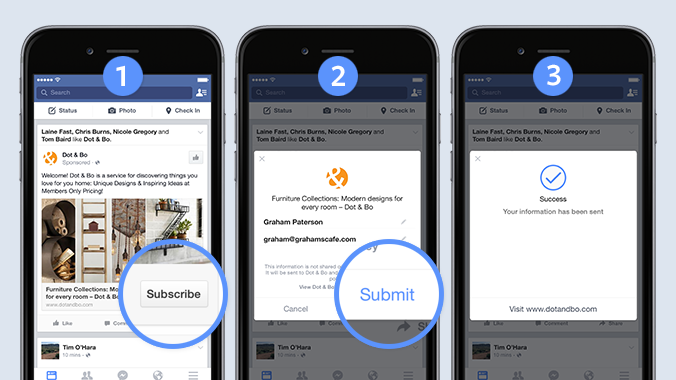
To get started with Lead Ads, simply:
1. Create a new campaign with the “Lead Generation” objective
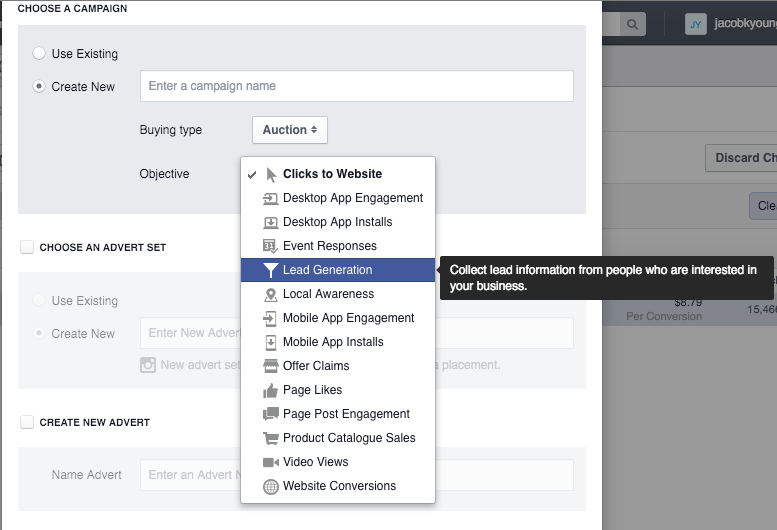
2. Build out your campaign/advert set, as you would for any campaign
3. Create your lead form at the advert level

4. Choose the questions you'd like added and optionally add up to three custom questions
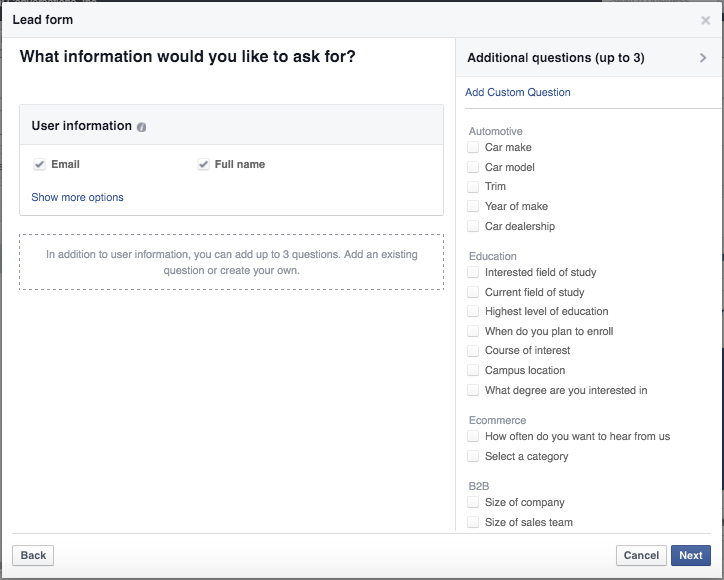
5. Link to your privacy policy, add your disclaimer and destination URL
6. Customize your form
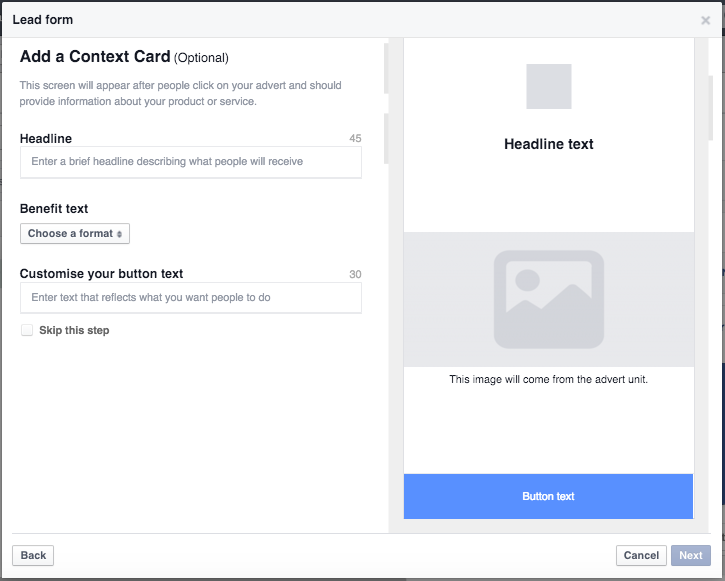
7. Preview then create your form
Now you're ready to get started with Facebook's newest and most powerful lead generation tool.
Tip: Twitter has had this campaign type for years, they call it Twitter Lead Cards.
2. Reporting, Reporting, Reporting
Some of the biggest wins are always found within the reporting section. One of the most important parts of reporting is the 'Breakdown' section.
- Are your mobile placements converting?
- What age group has the strongest CPA?
- What regions aren't converting?
- What gender is responding to your adverts?
These are all important questions that can be answered under the 'Breakdown' drop-down.

In this example, the Instagram placement converted a near 500% better than mobile news feed placement, at a fraction of the CPA. Knowing this, we'd shift more spend to Instagram and remove budget from the mobile news feed placement to maximize performance at our budget (if there's volume available).
3. Attribution models
It's important to understand Facebook's attribution models, where to change the view and what makes sense for your conversion goal. These are the 'rules' for how each conversion is counted, in regards to the timeframe after an interaction with your advert and the method of the interaction (click or view).
This is important to take note of so you have a clear understanding of the value of your conversions and how they compare to the other networks you may be running.
Within 'Manage adverts', the option to change the attribution model can be found under 'Columns' > 'Customize Columns…' > 'Change Attribution Window'.

4. Test Instagram
Since September 2015, Instagram placements have been made public in 30+ countries within the Facebook Ads Dashboard. Getting started with this is as simple as connecting an Instagram account and choosing the Instagram placement.
Break out some test budget and see how this placement compares.
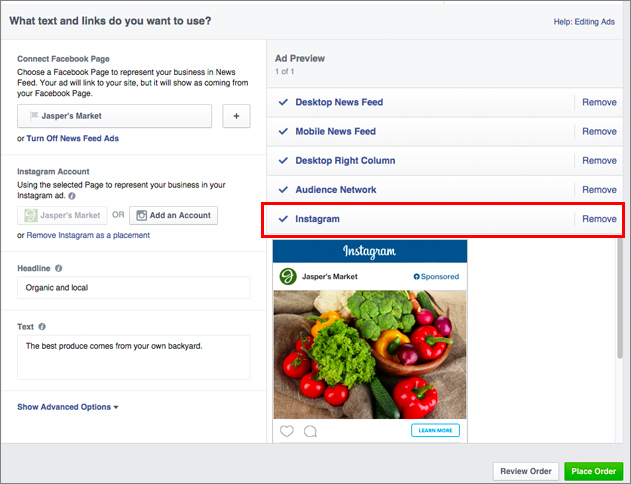
5. Lookalike audiences
I've found lookalike audiences to be one of the most effective targeting methods on paid social.
A lookalike audience is a targeting criteria where Facebook generates an audience of user who are similar to your current customers or audience.
This audience can be based off an email list, segments of your Facebook Pixel or any conversion goals you have set up. Facebook matches these users with Facebook profiles then finds similarities in demographics, interests, behaviors, etc. Lastly, Facebook uses these finding to generate a list of similar Facebook users which you can target in your campaigns.
Learn how to create a lookalike audience here.
6. Keep an eye on Facebook's location options
An often overlooked targeting criteria is Facebook's more granular location targeting options. It's important to keep this in mind while creating your campaigns and use the targeting option that makes the most sense for your business.

Are you trying to target people living in a specific city, or all people within this city? These are two very different targets.
Take for example, a local service business operating only in downtown SF. You wouldn't want to be targeting people visiting for the weekend, or commuting in for work.
7. Speak to your audience
With Facebook's granular targeting methods, in most cases you know who you're speaking to (at least the interest, behaviours, etc. that define your audience).
Use this knowledge to tie copy and creative closely with each specific audience you're targeting.
Targeting a recent homebuyer? How about something like “Your new home would be complete with [Brand Name's] contemporary/ modern furniture line”.
8. Remarketing
All digital marketers know the importance of remarketing, so don't level this out of your Facebook Ads strategy be left out.
Make sure to take advantage of Facebook's audience segmentation options, where you can include/exclude specific pages & domains, as well as choose the remarketing window length.
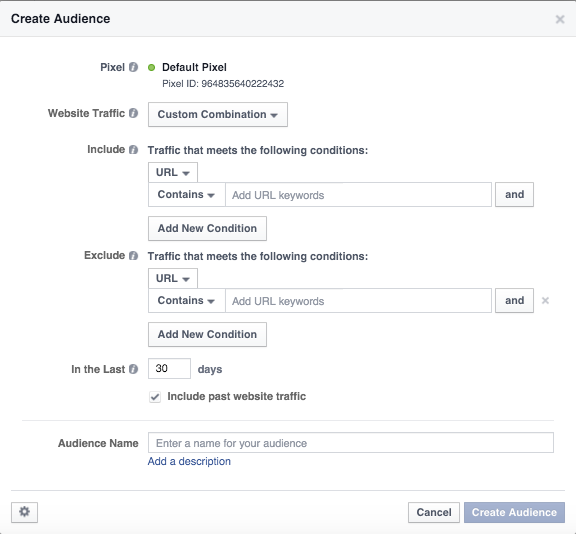
This feature allows advertisers to remarket specific products to users who've previously viewed or added them to their cart. The creative and copy of your ads will dynamically change based on what products your visitors have viewed.
9. Test multiple creative and copy
Always test many creative and copy variants to see which ones resonate best with your audience. Facebook will optimize ad serving based on performance and your conversion goal.
An interesting and relatively new creative type I recommend testing is the 'Carousel', which allows you to fit multiple images and links into a single creative.
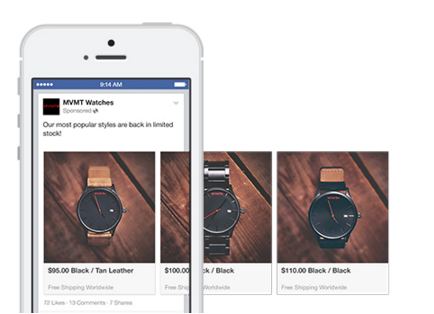
This creative type has been found to reduce your CPA by about 30-50% & decrease your CPC by 20-30% (according to Facebook).
Use this creative type to:
- Showcase multiple products
- Highlight multiple features
- Create a larger canvas
- Outline benefits
- Tell your brand's story
Tip: Don't forget to run a statistical significance test to see if the improvement you're seeing is indeed valid and not just by chance.
10. Breakout campaigns by placement
The different placements offered by Facebook perform very differently. It's important to keep an eye on their performance and where your spend is being directed (details of how to do this are found in #2 above).
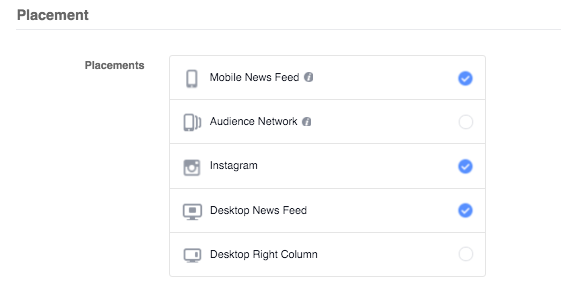
When optimizing for clicks, I find most of your budget will get pushed to mobile or audience network (since these have the most effective CPC), however these placements may typically not have the best overall performance.
In most cases, I find it makes sense to break out your campaigns by placement (or at least mobile vs. desktop). This is especially true if you're setting manual bids, or if your campaign is set to optimize for clicks.
Conclusion
I hope you find these Facebook Advertising tips & features useful. If you have any questions or additional tips/features that you think merit discussion, let us know if the comments section, or email me at jacob@cleverzebo.com.
About the Author: This guest post is written by Jacob Young, world-traveling digital nomad and Senior Manager, Ad Operations at Clever Zebo. Currently writing from the Co-Work office in Sayulita, Mexico. To learn how Clever Zebo can jumpstart your paid social efforts, shoot us a note at igor@cleverzebo.com or Tweet us at @CleverZebo.




